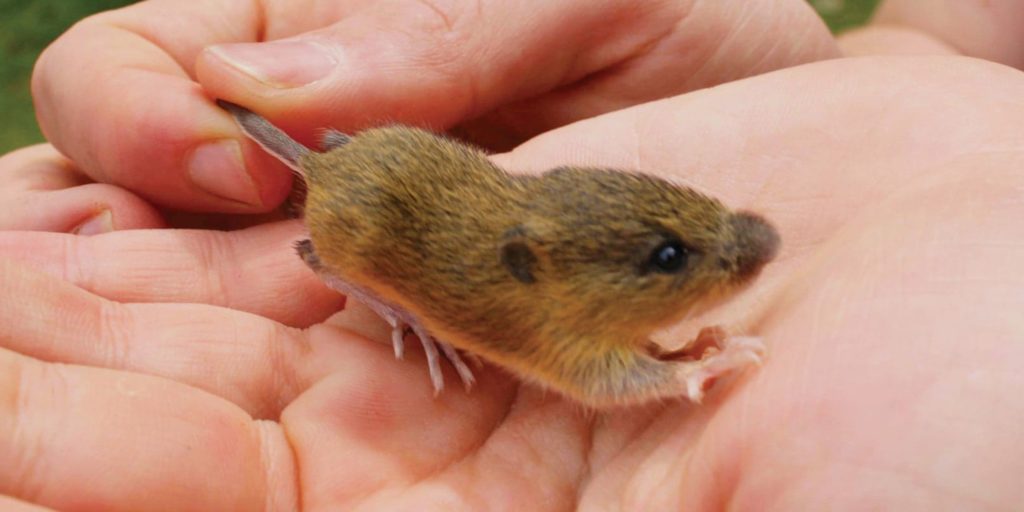Ontario Nature Blog
Receive email alerts about breaking conservation
and environmental news.
© Lora Denis
Short-tailed shrew © Jasmine Veitch
Though not as flashy as the moose or black bear, smaller mammals, such as mice, voles, and chipmunks, play key roles in their habitat. Small mammals provide food for predators, they distribute seeds for plants, and their burrows can influence the flow of precipitation over the land. While these cute critters may not be large in size, their role in the environment is prominent and extensive.
Studying small mammals is about more than what meets the eye – these populations can grant us with critical information on the health of the entire ecosystem and how it is changing. Delving into the world of small mammals presents us with the chance to push the limits on how much we know about our landscape’s past, present and future.

Deer mouse © Hayden Wilson
So what does it take to be a small mammal researcher (also known as a sm’mammaler)? It requires great endurance and determination, as researchers trek into the depths of Algonquin’s forests before the break of dawn (in rain or shine!), readily checking live-traps set the night before.
Researchers fully immerse themselves in the study from the chilly mornings of early May to the petering out of biting insects in late August. Any animals that may have scampered into the trap for a tasty snack are given a small metallic ear tag containing a unique numerical code. These tags allow researchers to recognize those they have caught before and to mark each animal’s place in the study.

Red squirrel © Patrick Moldowan
There are a vast number of research projects examining environmental change in an effort to pull us out of the dark and uncover the substantial impacts we are having on the earth. However, few of these studies possess as many years as the small mammal project. For over 60 years, researchers from the Algonquin Wildlife Research Station have been monitoring small mammals, a feat that is exceptionally rare. This gives us inside knowledge on how large-scale environmental changes, such as climate change, can impact the harmony of small mammals and their forest ecosystems.
Spanning over half a century, the information that has been collected over the past six decades provides us with powerful information on patterns that simply cannot be seen over a few years. Examining small mammal populations in undisturbed, natural areas allows us to compare these untouched regions to areas with greater human activity, such as those with logging practices. Monitoring projects often face the very real challenge of teaching us how we are impacting the health of our ecosystem. As our society continues to alter natural areas for human use, studies like these pull back the veil on how we are changing our surroundings and what consequences this will have.

Woodland jumping mouse © Jasmine Veitch
At its core, the small mammal project is about learning more about these tiny creatures and what they have to offer to the vast biosphere that surrounds them. But studies like this one don’t only help us preserve Algonquin’s forests and the wildlife held within. The small mammal project gives back to the people that care about our changing environment.
This research takes bold steps to give every one of us the opportunity to learn, and to gain a better understanding of the world around us. So the next time you step outside, take a moment to consider some well-deserved appreciation for small animals with a big impact.
Gananoque Lake Nature Reserve © Smera Sukumar
I caught a mouse with ear tags where I work on lake of two rivers , just wondering if there is a study taking place in the area ? Thank you
Hi Bradley,
That is a good question.
The Algonquin Wildlife Research Station may be able to offer some insight in this case: https://www.algonquinwrs.ca/index.php/contact-us/
Noah
The small and to some the insignificant will probably inherit the earth. They live short lives and I often wonder why in the scheme of things we get to live much longer and change our world to our liking. I hope natural life lasts a little while longer.
Are the results of this research available to interested amateurs?
Hello Pat,
You can find more information about the project here: http://www.appliedevoeco.org/
If you have any further questions there is a contact form on their web page.
Regards,
Jaklynn, Ontario Nature
Fascinating!
Cheers to the sm’mammalers! Certainly a key piece in the environmental puzzle.